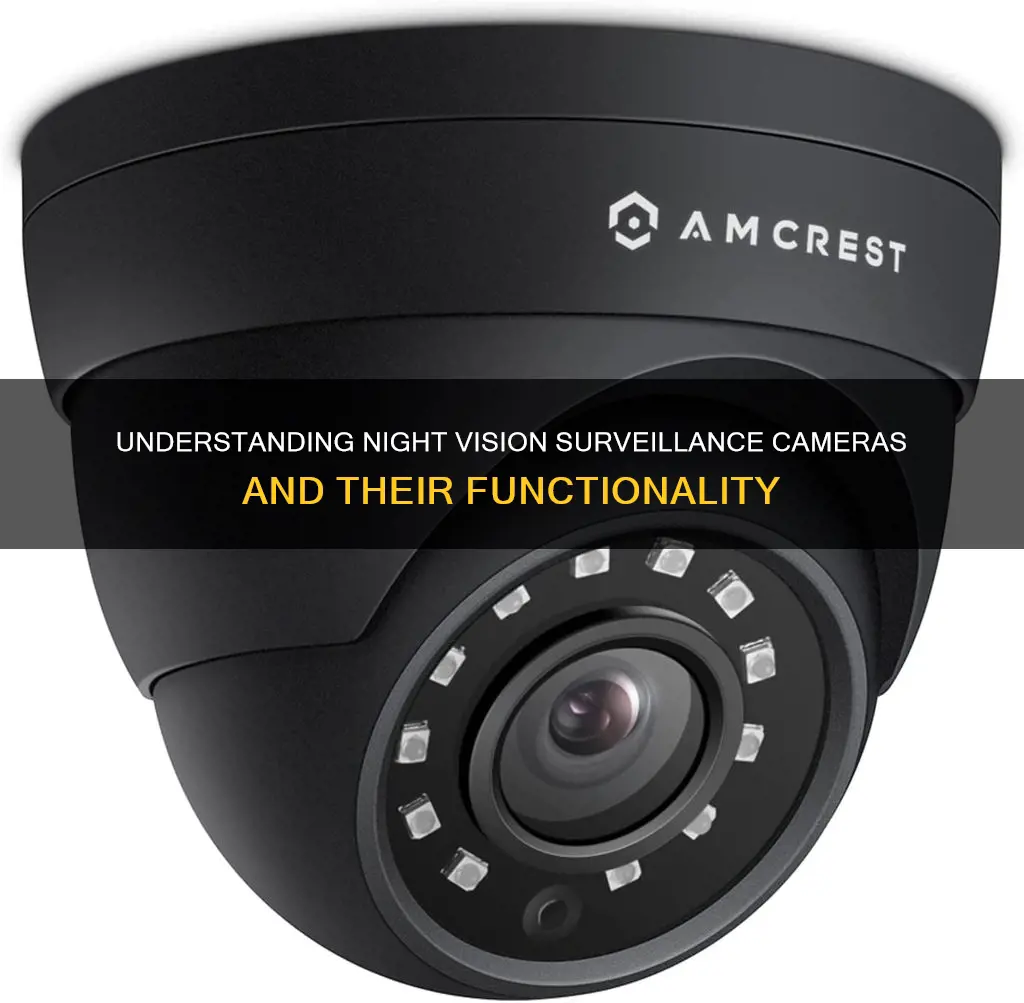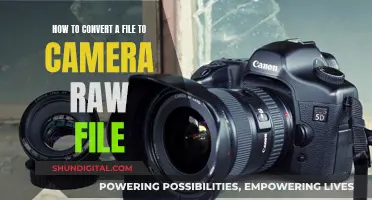
Night vision surveillance cameras are an important security feature for homes and businesses. They use infrared light to capture images in the dark, which is invisible to the human eye. This technology has come a long way since its early development before World War II, and now night vision cameras are widely available and used to monitor properties at night, acting as a deterrent to criminals and providing evidence in the case of a break-in.
Night vision cameras can be either wired or wireless and are designed to be used either indoors or outdoors. They are usually equipped with motion detection and can be set up to send alerts to the user's phone or email when motion is detected. They can also be paired with smart home devices and voice assistants.
| Characteristics | Values |
|---|---|
| Video Quality | Crisp, clear video, even in complete darkness |
| Resolution | 600TVL CCTV Cameras to 4K 12 Megapixel IP cameras |
| Day & Night Technology | Switch to black & white mode in low light |
| Video Signal Types | Analog, HDCVI, and IP |
| Field of View | 120-155 degrees |
| Night Vision Range | 10-200 feet |
| Lighting | Infrared, full colour, spotlight |
| Installation | Wired, wireless, wire-free |
| Power | Rechargeable battery, solar power, GFCI outlet |
| Storage | Local, cloud, microSD card, USB |
| Weatherproofing | IP65 rating or higher |
What You'll Learn

Night vision cameras can see between 10 to 200 feet in the dark
Night vision surveillance cameras are an effective way to monitor your home or business 24/7. They can capture sharp, clear images or videos in low-light conditions or even in complete darkness. The night vision feature in security cameras is based on infrared bulbs. Infrared is a form of light invisible to the human eye. When visible light is diminished, infrared light bulbs will turn on and allow the device to create an image using infrared.
The lens aperture also affects the night vision camera's performance. The aperture is the opening of a lens that allows light to enter. A larger lens aperture will allow more light to pass through, resulting in clearer images. Additionally, the image sensor is crucial in determining the clarity of images from night security cameras. Larger sensors can gather more light, resulting in brighter images with higher clarity and more details, especially in low-light conditions.
The resolution of the night vision camera also plays a role in its ability to see in the dark. A higher resolution camera will be able to produce clearer images even in low-light conditions. For most households, a 720p camera is sufficient, but higher resolutions like 1080p, 4K, or even 8K are available for improved clarity and detail.
It's worth noting that the location of the night vision camera can also impact its range of view in the dark. Mounting the camera higher up on walls can provide a wider angle of view, but if placed too high, the camera might only capture blurry images. Additionally, ensure that there are no obstructions like trees or walls blocking the camera's line of sight.
Overall, night vision surveillance cameras with a range of 10 to 200 feet can effectively monitor your property, deter potential intruders, and provide peace of mind.
Charging Your ADT Camera Battery: A Step-by-Step Guide
You may want to see also

Infrared light is invisible to humans but can be detected by cameras
Night vision surveillance cameras are used to see in low-light conditions. There are two types of night vision: natural night vision, called scotopic vision, and night vision achieved through night-vision devices. Humans have poor night vision compared to many animals, such as cats, dogs, foxes, and rabbits, due to the lack of a tapetum lucidum, a tissue behind the retina that reflects light back through the retina, thereby increasing the amount of light available to the photoreceptors.
Night vision devices can be broadly divided into three categories: image intensification, active illumination, and thermal imaging. Image intensification magnifies the amount of received photons from natural sources such as starlight or moonlight. Active illumination combines imaging intensification technology with an active source of illumination in the near-infrared (NIR) or shortwave infrared (SWIR) band. Thermal imaging detects temperature differences between foreground and background objects.
Infrared light is a portion of the light spectrum that follows red light and has longer wavelengths than visible light, typically ranging from 700 nanometers to one millimeter. These wavelengths are invisible to humans in almost all conditions. However, in certain situations, humans can perceive infrared light as a flash of green light when concentrated bursts enter the eye. This phenomenon occurs because, although typically, a particle of light called a photon is absorbed by the retina to create a photopigment molecule that begins the process of converting light into vision, it is possible for two photons to be absorbed at once by a single photopigment when light is concentrated or rapid. The combined energy of these two particles is then enough to activate the pigment and allow the eye to see what is normally invisible.
Infrared light is commonly used in remote controls, thermal imaging cameras, and night vision goggles because it can be detected as heat. It is also used in astronomy to perceive faint objects that would otherwise be undetectable. While it is generally challenging for humans to see infrared light, some animals, such as snakes and bedbugs, can detect it.
Infrared light is widely used in night vision surveillance cameras. These cameras emit infrared light, which illuminates the surroundings, and an image sensor then creates black-and-white night vision images. Infrared cameras have the advantage of providing a wider illumination range than visible light, and since infrared light is invisible to the human eye, these cameras are more discreet. However, one drawback is that infrared cameras produce black-and-white footage.
The Intricate Art of Crafting Camera Lenses
You may want to see also

Night vision cameras can be wired or wireless
Night vision surveillance cameras are an essential feature for 24/7 video security. They are available in both wired and wireless options, each with its own advantages and suited to different needs.
Wireless night vision cameras offer flexibility in installation, allowing you to place them in secluded and dark areas without the hassle of running power cables. They are often battery-powered, with long battery lives that can last up to two years. Wireless cameras are ideal for monitoring spacious backyards or outdoor sheds, providing security for areas that might be difficult to reach with wiring.
On the other hand, wired night vision cameras offer stable and continuous recording without the need to worry about battery life. They are usually connected to a local storage device, such as a network video recorder (NVR) or a digital video recorder (DVR), which can serve as a backup for your footage. Wired cameras may also have advanced features that require a subscription, such as artificial intelligence capabilities for object detection and familiar face recognition.
Both wired and wireless night vision cameras can provide infrared night vision, which is superior for covert surveillance as it is invisible to the human eye and provides a wider illumination range. However, infrared results in black-and-white footage. Alternatively, some cameras offer colour night vision using visible light sources, which provide more details but may give away the camera's position.
When choosing between wired and wireless night vision cameras, consider factors such as installation flexibility, power requirements, storage options, and the specific features that meet your security needs.
Loading Camera Raw Presets: XMP Files Explained
You may want to see also

They can be installed indoors or outdoors
Night vision surveillance cameras can be installed both indoors and outdoors. When installing a night vision camera outdoors, it's important to consider the camera's ability to withstand different weather conditions and its range of vision. Some cameras may be more suitable for capturing license plates or people's faces, while others have a wider field of view.
For example, the Lorex 4K Nocturnal Smart IP Camera is designed for outdoor use and offers a night vision range of up to 90 feet in total darkness, or 130 feet with ambient lighting. The Blink Outdoor camera is another option that can be used outdoors and offers a wire-free installation, making it easy to place in secluded and dark areas.
When installing a night vision camera indoors, it's important to consider the amount of space that needs to be covered and the potential for glare from reflective surfaces. The Nest Cam (wired, indoor) is a good option for indoor use as it offers a sufficient night vision range of up to 15 feet and has high-powered 850nm infrared LEDs that provide better illumination than the 940nm type.
In addition to indoor and outdoor installations, some night vision cameras can also be used in both environments, such as the Arlo Pro 3, which offers both infrared and color night vision options.
When choosing a night vision camera, it's important to consider factors such as price, video quality, audio, smart platform integration, artificial intelligence features, and video storage options, in addition to the specific requirements of the intended installation location.
Virtual Tour Camera Mode: An Immersive Experience
You may want to see also

Night vision cameras can cost between $59.99 to $299.99
Night vision surveillance cameras are cameras that can record clear video even in complete darkness. They are used for both indoor and outdoor security. Night vision cameras use infrared light, which is invisible to the human eye, to illuminate the camera's surroundings. The image sensor then creates black-and-white night vision images.
Night vision cameras can cost anywhere from $59.99 to $299.99, depending on the features and specifications. For example, a basic indoor security camera with night vision capabilities can be purchased for around $60, while a more advanced outdoor camera with a longer night vision range and higher resolution can cost upwards of $200.
When choosing a night vision camera, it is important to consider the type of video signal that is compatible with your security recorder. The three main types of video signals are Analog, HDCVI, and IP. You should also consider the resolution of the camera, with options ranging from 600TVL to 4K 12 Megapixel.
Another factor to keep in mind is the night vision range. For outdoor use, a camera with a night vision range of at least 40 feet is recommended, while indoor cameras require a shorter range of up to 20 feet. Some cameras also offer adjustable infrared intensity to prevent glare in indoor spaces.
In addition, some night vision cameras have smart features such as person detection, activity zones, and two-way audio. These additional features may increase the cost of the camera but can provide enhanced security and convenience.
Overall, when selecting a night vision surveillance camera, it is important to consider your specific needs, budget, and compatibility with your existing security system.
The Evolution of Fisher Price Cameras Over the Years
You may want to see also
Frequently asked questions
A night vision surveillance camera is a camera that can record clear footage in the dark. They are used for security purposes, both inside and outside of buildings.
Night vision works by adding infrared light to the camera's field of view. Cameras can detect infrared light, which is invisible to humans, and use it to create an image.
The best night vision security camera depends on your needs. The Nest Cam Indoor is the best indoor camera, while the Arlo Pro 4 Wireless is the best outdoor option.
To improve the night vision of your security camera, you can add more lighting to the area it is focusing on.







